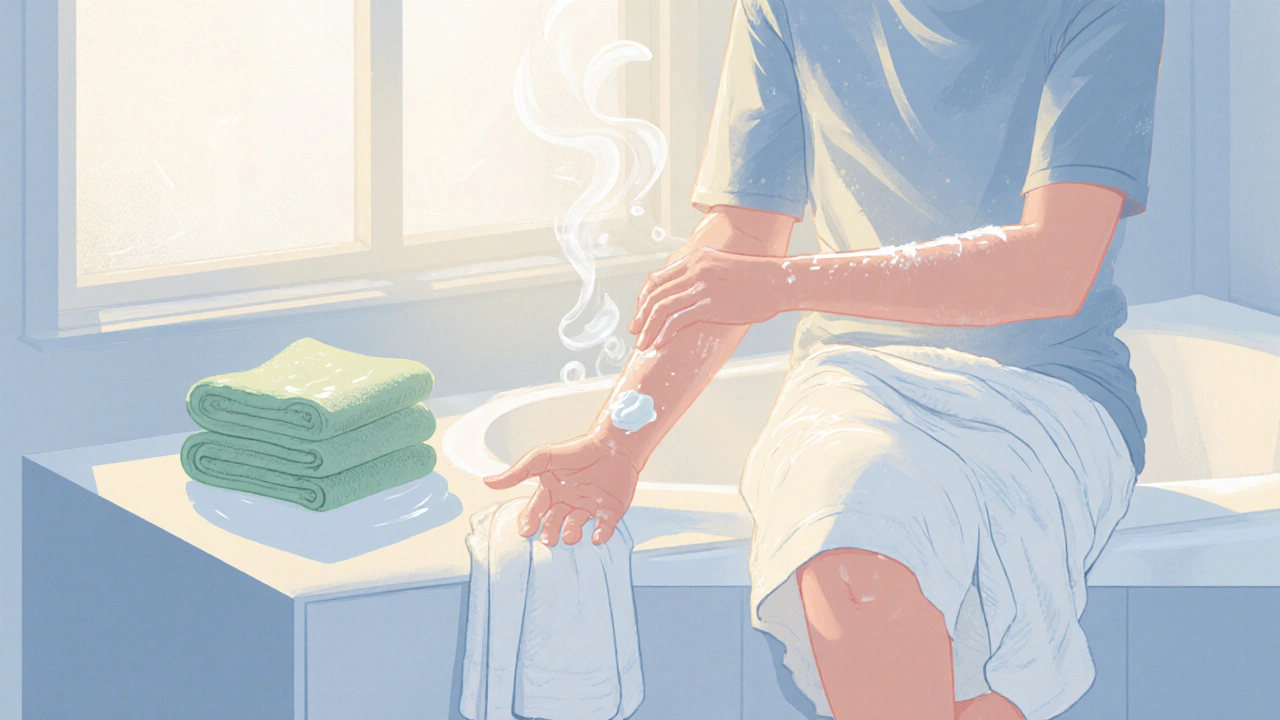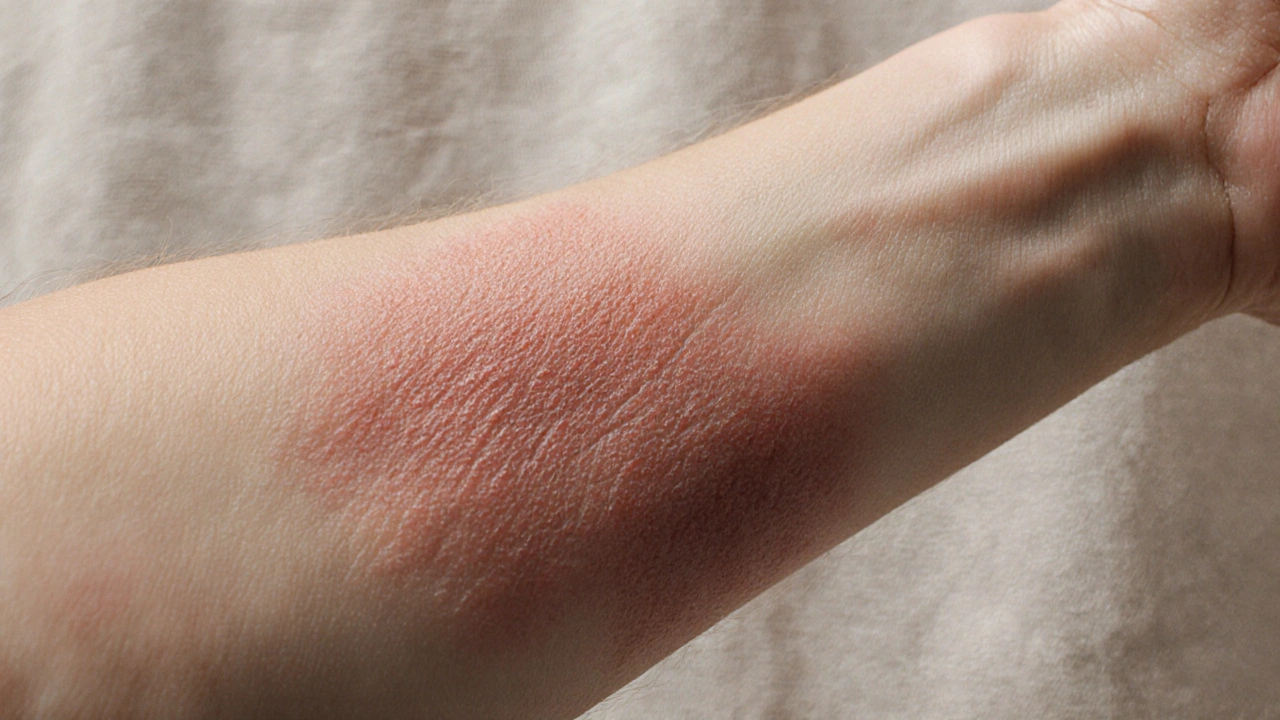Eczema Itch Relief Strategy Planner
Your Eczema Itch Relief Plan
Select your symptoms and triggers to generate a personalized strategy.
That relentless itch can feel like a tiny drill on your skin, and when it’s tied to Eczema a chronic inflammatory skin condition also known as atopic dermatitis, characterized by dry, red, and itchy patches, the frustration multiplies. Below are proven strategies that stop the cycle of scratching, soothe the skin, and keep flare‑ups under control.
Key Takeaways
- Moisturize multiple times a day with a fragrance‑free emollient.
- Use targeted anti‑itch meds like topical corticosteroids or antihistamines when needed.
- Cool compresses, wet wrap therapy, and proper bathing habits cut itching instantly.
- Avoid triggers such as harsh soaps, high‑temperature showers, and stress.
- Track symptoms to spot patterns and adjust treatment early.
Understand Why the Itch Happens
The sensation of Itching a neuro‑cutaneous response triggered by inflammation, dry skin, and histamine release in eczema is not just an annoyance-it’s a signal that the skin barrier is compromised. When the barrier loses moisture, nerve endings become hyper‑responsive, sending itch signals to the brain. Scratching temporarily relieves the urge but tears the skin, invites infection, and fuels more inflammation, creating a vicious loop.
Build a Skin‑Barrier Defense
The cornerstone of itch control is a solid barrier. Apply a thick, fragrance‑free Moisturizer also called an emollient or ointment; it seals water into the outer skin layer and restores lipids at least twice daily-right after bathing, before bed, and anytime the skin feels tight.
Best choices in 2025 include:
- Ceramide‑rich creams (e.g., CeraVe Moisturizing Cream)
- Petrolatum‑based ointments (e.g., Vaseline)
- Shea‑butter or oat‑based lotions for sensitive skin
Pat the product onto damp skin; rubbing can irritate, while a gentle press locks in moisture.
Target Inflammation with Prescription‑Strength Options
When the itch is driven by active inflammation, short‑term use of a Topical corticosteroid a steroid cream, ointment, or lotion that reduces redness, swelling, and itch by dampening immune activity can break the cycle. Choose potency based on the affected area:
- Low‑potency (hydrocortisone 1%) for face and skin folds.
- Medium‑potency (triamcinolone 0.1%) for arms and legs.
- High‑potency (clobetasol 0.05%) for thick plaques on elbows or knees, but limit to two weeks.
Apply a thin layer once or twice daily, following the dermatologist’s tapering plan to avoid steroid‑withdrawal.

Quick‑Act Antihistamines for Night‑time Relief
If itching spikes at night, an oral Antihistamine a medication that blocks histamine receptors, reducing itch and helping you sleep can be a game‑changer. Non‑sedating options like cetirizine keep you alert during the day, while sedating choices such as diphenhydramine or hydroxyzine are best reserved for bedtime.
Start with the lowest effective dose; many patients find 10mg of cetirizine at night enough to cut the itch without daytime drowsiness.
Cool Compresses - Instant Soothing
Cold temperature numbs nerve endings and reduces inflammation. A Cool compress a damp, chilled cloth applied to the skin for 5‑10 minutes can calm an acute flare within minutes.
- Soak a clean washcloth in cool water, wring out excess, and lay it on the itchy area.
- For extra relief, add a few drops of colloidal oatmeal to the water before soaking.
- Repeat up to three times a day, avoiding ice directly on the skin to prevent frostbite.
Wet Wrap Therapy - Lock in Moisture
For stubborn flare‑ups, especially on the limbs, Wet wrap therapy a method where moisturized skin is covered with a wet layer followed by a dry layer, enhancing absorption of topical meds and reducing itch is highly effective.
- Apply a thin layer of moisturizer or prescribed corticosteroid to clean skin.
- Wrap the area with a cotton garment (e.g., T‑shirt) that has been soaked in cool water and wrung out.
- Cover the wet layer with a dry, breathable fabric (e.g., a second cotton shirt) to keep moisture in.
- Leave on for 30‑60 minutes, then remove, shower gently, and re‑moisturize.
Do this once daily during a flare; many report a 50% reduction in itch intensity after three nights.
Consider Non‑Steroidal Topicals
If you’re wary of steroids, a Calcineurin inhibitor a prescription cream like tacrolimus or pimecrolimus that modulates the immune response without thinning the skin offers an alternative for delicate areas such as the face or neck. These agents work slower than steroids but are safe for long‑term use.
Identify and Avoid Common Triggers
Even the best skin‑care routine can fail if you’re constantly exposing yourself to irritants:
- Harsh soaps, detergents, and scented lotions - switch to fragrance‑free, pH‑balanced cleansers.
- Hot showers - keep water lukewarm and limit bathing to 10‑15 minutes.
- Wool or synthetic fabrics - opt for cotton or soft bamboo blends.
- Stress - incorporate mindfulness, short walks, or breathing exercises; cortisol spikes can aggravate inflammation.
Track Symptoms to Fine‑Tune Your Plan
Use a simple journal or a skin‑tracking app to note:
- Date and time of flare‑up.
- Possible trigger exposure.
- Products used (moisturizer, steroid strength, antihistamine).
- Itch severity on a 1‑10 scale.
Patterns emerge quickly, allowing you and your clinician to adjust treatments before a full‑blown flare.
Quick Comparison of Over‑the‑Counter Itch‑Relief Options
| Product Type | Key Ingredient | Primary Benefit | Best Use Case |
|---|---|---|---|
| Hydrating Cream | Ceramides & Hyaluronic Acid | Long‑lasting moisture | Daily maintenance |
| Anti‑Itch Lotion | Colloidal Oatmeal | Immediate soothing | During mild flare‑ups |
| Topical Antihistamine | Diphenhydramine | Reduces histamine‑driven itch | Night‑time itching |
| Barrier Repair Ointment | Petrolatum + Dimethicone | Seals moisture, protects | Severe dryness, post‑shower |
When you need quick eczema itching relief, start with a barrier‑repair ointment, then add a targeted anti‑itch product if the itch persists.
When to Seek Professional Help
If you notice any of the following, book an appointment:
- Skin infection signs - redness spreading, warmth, pus.
- Persistent itch despite daily moisturising and OTC measures.
- Severe sleep disruption affecting daily function.
- Uncertain diagnosis - rash that doesn’t fit typical eczema patterns.
A dermatologist can prescribe stronger agents, discuss phototherapy, or explore biologic treatments such as dupilumab for moderate‑to‑severe cases.
Bottom Line: A Layered Approach Wins
Managing eczema itch isn’t about a single miracle product; it’s about building a routine that protects the barrier, calms inflammation, and removes triggers. Moisturize often, treat flare‑ups early with the right topical, use cool compresses or wet wraps for instant relief, and keep an eye on lifestyle factors. With these steps, most people see a noticeable drop in itch intensity within a week and enjoy smoother, calmer skin long term.
Frequently Asked Questions
Can I use coconut oil as a moisturizer for eczema?
Coconut oil can help some people, but it’s high in oleic acid, which may irritate sensitive skin. If you choose it, test on a small patch first and combine with a ceramide‑rich cream for better barrier support.
How often should I apply a topical steroid during a flare?
Typically once or twice daily, following your doctor’s strength recommendation. Limit continuous use to 1‑2weeks for medium or high‑potency steroids, then taper down to prevent skin thinning.
Is it safe to use antihistamines every night?
Occasional nightly use of a sedating antihistamine is generally safe for adults. Long‑term daily use should be discussed with a doctor, especially if you have liver issues or take other medications.
What’s the difference between wet wrap therapy and regular bandages?
Wet wraps are designed to keep a moist environment directly against the skin, boosting medication absorption and soothing dryness. Regular bandages are dry and can trap heat, sometimes worsening irritation.
Can stress really make eczema worse?
Yes. Stress releases cortisol, which can weaken the skin barrier and increase inflammation, leading to more itch and flare‑ups. Mind‑body techniques like meditation or short walks often help reduce symptoms.


 Medications
Medications
Tracy Harris
October 6, 2025 AT 15:30One must recognize that merely applying a moisturizer without rigorous adherence to barrier‑repair principles is tantamount to a superficial Band‑Aid on a festering wound; the literature unequivocally demands twice‑daily application, immediate post‑bath sealing, and the exclusive use of fragrance‑free, ceramide‑laden formulations. Moreover, the casual recommendation of “some lotion” betrays a lamentable ignorance of dermatological hierarchy and invites relentless itch cycles.
Sorcha Knight
October 13, 2025 AT 14:10Oh wow, the struggle is REAL 😅! If you think a quick splash of water will save you, think again. A proper cool‑compress routine can shut that itch down faster than your favorite binge‑watch series, trust me.
Jackie Felipe
October 20, 2025 AT 12:50i use plain soap and it works fine but sometimes i forget to pat dry and it gets itchy later. also i think a lil bit of extra moisturizer after shower helps a lot.
debashis chakravarty
October 27, 2025 AT 11:30While the preceding statements appear well‑intentioned, they suffer from a lack of precision: the phrasing “use a moisturizer” should be supplanted by “apply a lipid‑restorative emollient containing ceramides”. Furthermore, the suggestion to “use cool compresses” must be qualified with duration and temperature parameters to avoid iatrogenic injury.
Daniel Brake
November 3, 2025 AT 10:10Contemplating the itch as a metaphor for the restless mind, one may ask whether the pursuit of comfort merely masks a deeper disquiet. Yet, the pragmatic path remains: consistent barrier maintenance, judicious steroid use, and mindful stress reduction converge to silence that incessant whisper.
Emily Stangel
November 10, 2025 AT 08:50Effective management of eczema‑induced pruritus necessitates a multilayered approach that integrates skin‑barrier reinforcement, anti‑inflammatory therapy, and lifestyle modulation; each component interlocks to form a cohesive therapeutic architecture. Firstly, the cornerstone of any regimen lies in the diligent application of a barrier‑repair moisturizer, preferably one enriched with ceramides, hyaluronic acid, and petrolatum, applied to damp skin within three minutes of bathing to lock in hydration. Secondly, the judicious use of topical corticosteroids, calibrated to potency based on anatomical location and severity, serves to quell acute inflammation while minimizing the risk of atrophy when employed in accordance with a tapering schedule. Thirdly, oral antihistamines, particularly sedating agents such as hydroxyzine, may be reserved for nocturnal symptom control, thereby improving sleep quality and reducing the propensity for scratching. Fourthly, adjunctive physical modalities-including cool compresses applied for five to ten minutes, and wet‑wrap therapy employing a moist cotton layer beneath a dry barrier-provide immediate symptomatic relief and enhance percutaneous drug absorption. Fifthly, avoidance of known irritants-harsh soaps, synthetic fabrics, and elevated water temperatures-must be systematically enforced, with a preference for fragrance‑free, pH‑balanced cleansers and breathable natural fibers. Sixthly, stress management techniques such as mindfulness meditation, progressive muscle relaxation, and regular aerobic exercise have been documented to attenuate cortisol‑mediated flare‑ups. Seventhly, meticulous documentation of flare patterns via a symptom journal or digital application empowers both patient and clinician to preemptively adjust therapeutic intensity. Eighthly, in recalcitrant cases, specialist consultation may yield advanced options such as calcineurin inhibitors for facial involvement or biologic agents like dupilumab for moderate‑to‑severe disease. Ninthly, education on proper application methods-patting versus rubbing-to avoid mechanical irritation is essential. Tenthly, regular follow‑up appointments enable dynamic reassessment of treatment efficacy and safety. Eleventhly, the inclusion of family members in care plans can foster a supportive environment conducive to adherence. Twelfthly, awareness of secondary bacterial colonization, prompting timely antimicrobial intervention, mitigates the risk of infection. Ultimately, by adhering to this comprehensive, evidence‑based protocol, most individuals will experience a substantial diminution of itch intensity within a week, paving the way toward sustained cutaneous tranquility.
Adam Khan
November 17, 2025 AT 07:30While your exposition is commendably exhaustive, the omission of the term “transepidermal water loss (TEWL)” constitutes a notable lacuna; incorporating TEWL metrics would enhance the scientific rigor of your protocol and facilitate quantitative monitoring of barrier integrity.